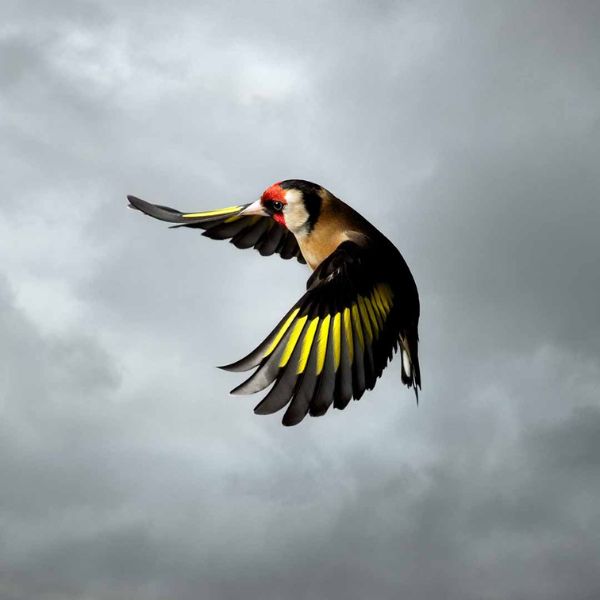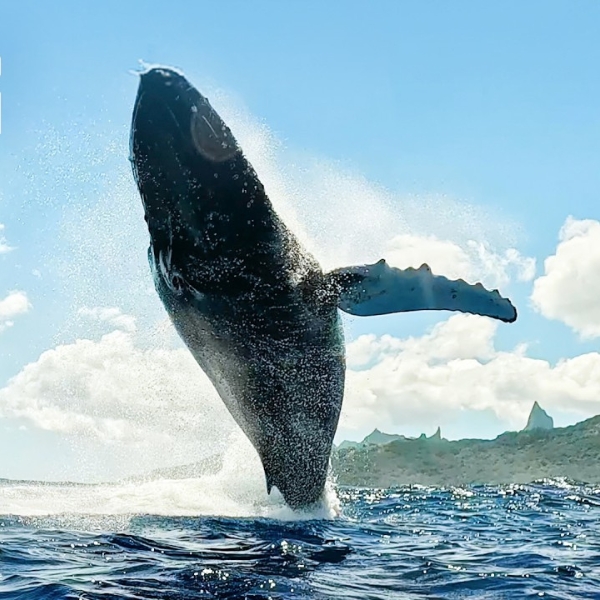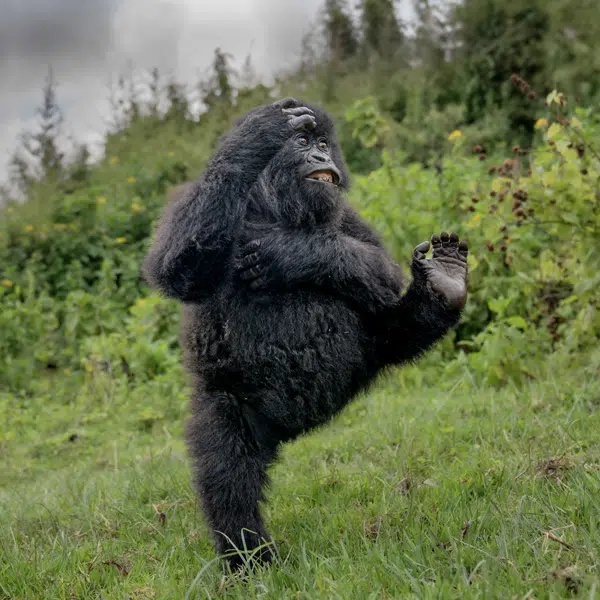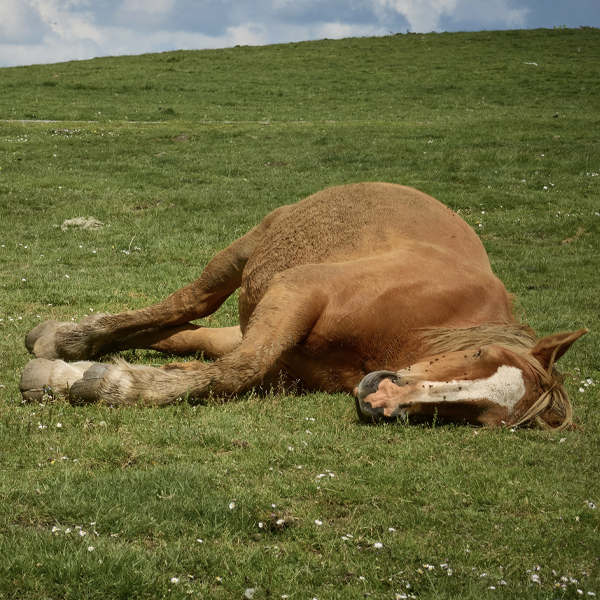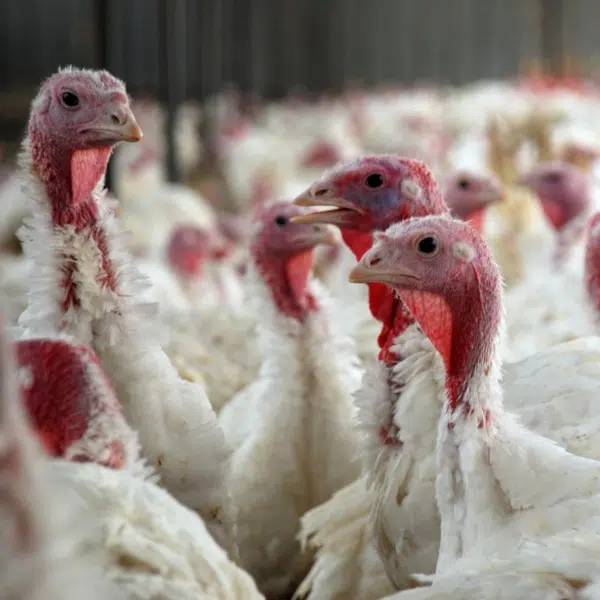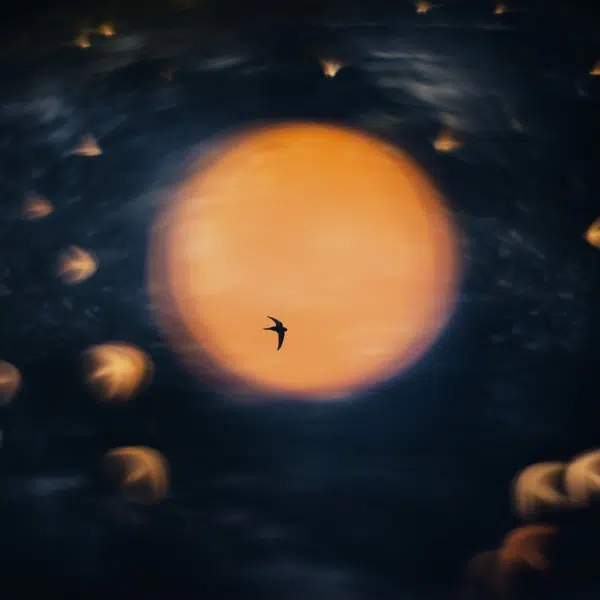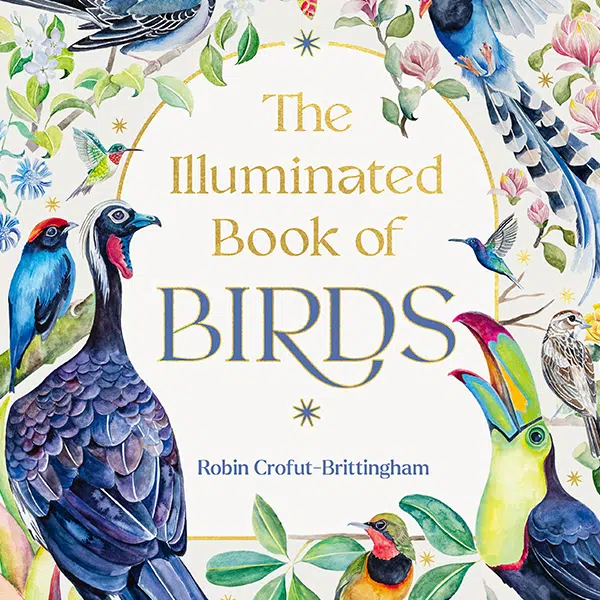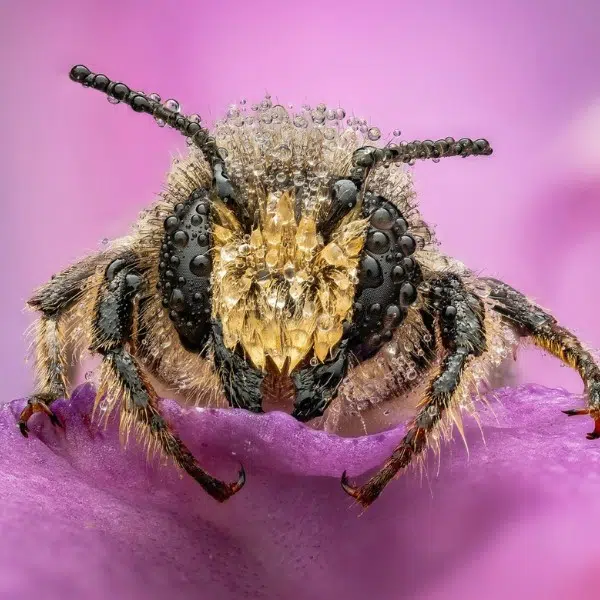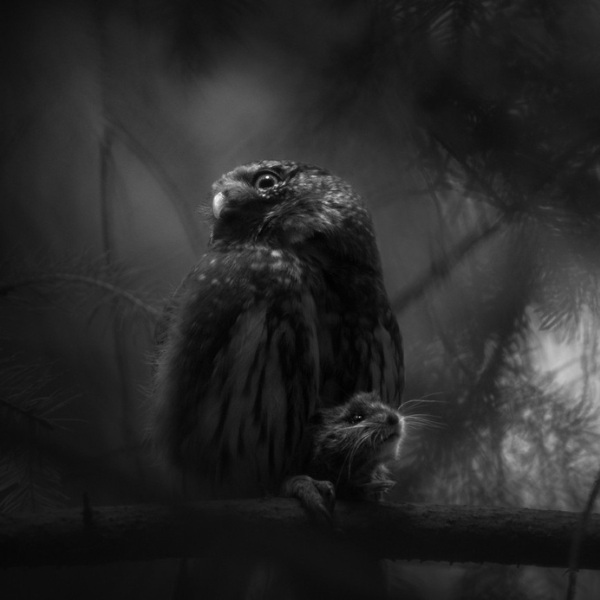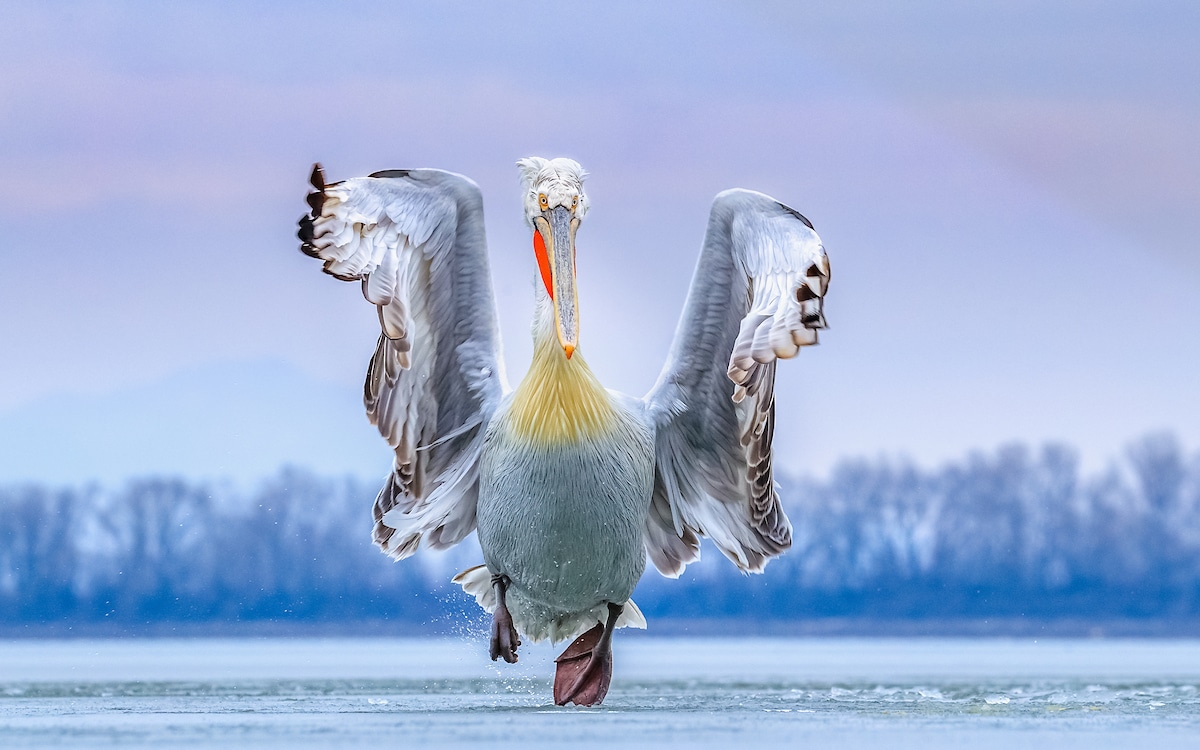
“Dalmatian Pelican Pelecanus crispus.” by Caron Steele (United Kingdom). Winner, Bird Photographer of the Year and People's Choice Category. Gold Award, Best Portrait. Photo taken at Lake Kerkini, Greece.
‘On arriving in Greece to photograph the Dalmatian Pelicans in their breeding plumage I discovered that Lake Kerkini, their favored haunt, had frozen for the first time in 16 years; all the pelicans had flown off. Fortunately, a few holes started to thaw in the lake and the birds slowly began to return. Unused to the slippery icy surface of the lake they regaled us with hilarious antics as they slid across the lake surface trying to retain control as they took off and landed. I was lucky enough to capture one such rare moment when this magnificent pelican ran towards me across the ice at dusk before taking off. It was a truly unique experience, both magical and comical at the same time. And the image remains a moment of pure joy captured forever.’
Now in its fourth year, the Bird Photographer of the Year (BPOTY) contest continues to showcase the best avian photography from around the world. The 2019 photo competition saw over 13,500 images submitted from 63 different countries. The expert panel of judges, led by naturalist and TV presenter Chris Packham, had the difficult task of selecting one overall winner, as well as six category winners and two special award recipients.
In the end, it was UK photographer Caron Steele who took home the top prize and was named 2019 Bird Photographer of the Year for her incredible photo of a Dalmatian Pelican. Steele's image captures an unusual moment in time. Taken at Lake Kerkini in Greece, she happened to be on site when the lake froze for the first time in 16 years. By seizing the moment, she got a unique photo of a pelican attempting to navigate this slippery surface for the first time.
For Steele, who studied zoology and only took up photography in 2014, the win is a confirmation that she's headed in the right direction. “I am so passionate about conservation and am keen to find an angle where I can help make a significant difference; winning this award has spurred me on to renew my efforts,” she shared. “In today’s hectic life I think it is vital we strive to save the beautiful natural world around us, as ultimately I believe it will save us. Photography and being at one with nature brings a sense of calm, joy and appreciation that can strip away the stresses of life.”
Across a wide variety of categories that celebrate both creative and documentary bird photography, the winning shots give the public a deeper understanding of the state of birds around the world today. To celebrate the inspiration that can come from contact with wildlife, BPOTY introduced a new special award for the 2019 competition. With his photograph of Emperor Penguins in Antarctica, Martin Grace was named the recipient of the inaugural Inspirational Encounters Award. In sharing his moving experience with these penguins, Grace celebrates the positive impact of the avian world on humanity.
Take a look at some of the award-winning bird photography from the 2019 Bird Photographer of the Year contest and get inspired to go out and take some of our own wildlife photos.
The winners of the 2019 Bird Photographer of the Year celebrate the beauty of the avian world.
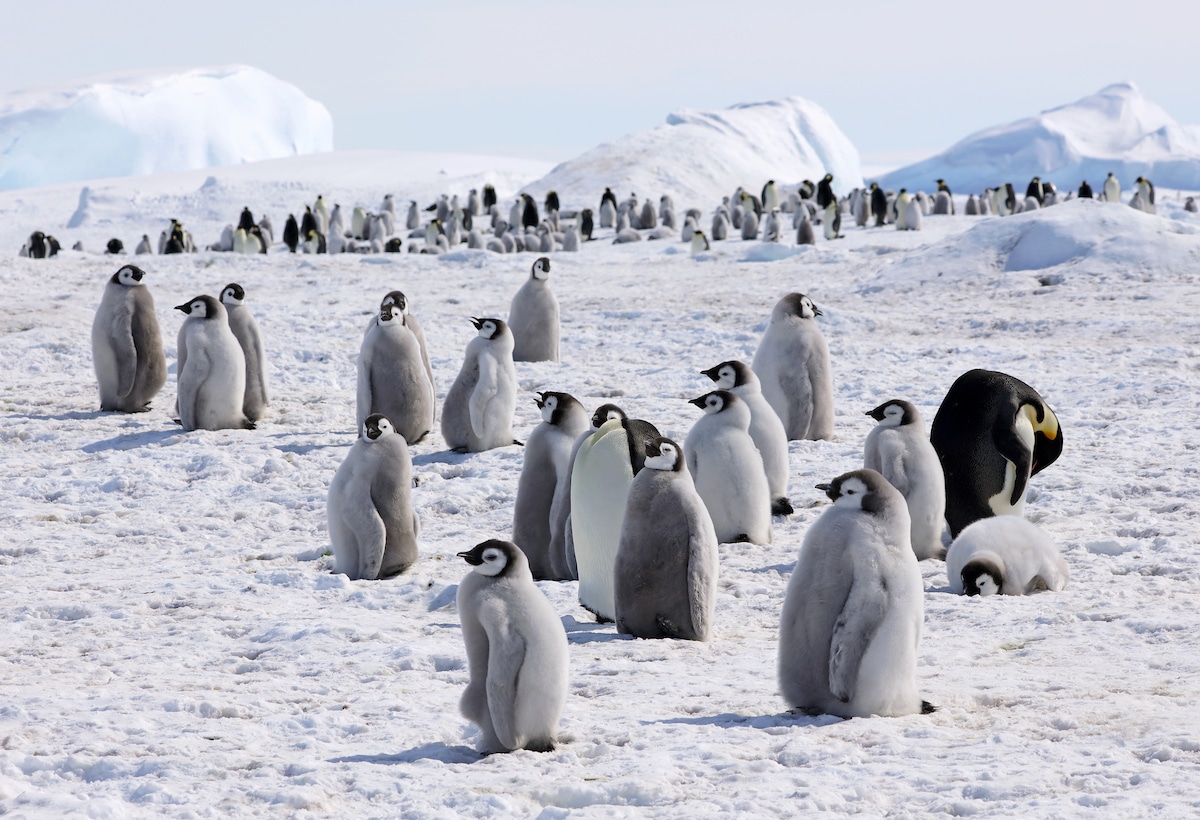
“Emperor Penguin Aptenodytes forsteri.” by Martin Grace (United Kingdom) Winner, Inspirational Encounters Award. Photo taken in Snowhill Island, Weddell Sea, Antarctica.
‘Emperor. Penguin. Individually words of little distinction, but together an icon of near-mythical proportion. Flightless. The only bird that completely forgoes land. The march. The crazily dedicated parenting. Arguably the most difficult bird in the world to see. But forget for now the travel nightmare, the two days turbulent torture of the ‘never-again' Drake Passage, the teetering on the edge of will-we, won’t-we? Decades of aspiration are finally approaching a culmination. An unexpected route appears through storm-packed sea ice and Antarctica’s fickle summer opens a calm window of blue. This miraculous conspiracy permits no more than half an hour at the colony, including walking time from landing. Borrowed boots pinch, clothing is stiflingly excessive, frustration also boils as the camera tangles inside the rucksack. But actually having made it is too overwhelming, too emotional. I shoot a few images then put the camera away, and for fifteen minutes it is just me, the Emperors and heaven.'

‘Black-crowned Night-heron Nycticorax nycticorax.' by Thomas Hinsche (Germany). Winner, Best Portfolio. Photo taken in Kiskunság National Park, Hungary.
‘This night-heron was hunting at twilight and with the help of several flashlights I was able to take this picture in the failing light. In the warm summer month of June at the Kiskunság National Park in Hungary, waiting for such photo-opportunities is a pleasure rather than a hardship.’
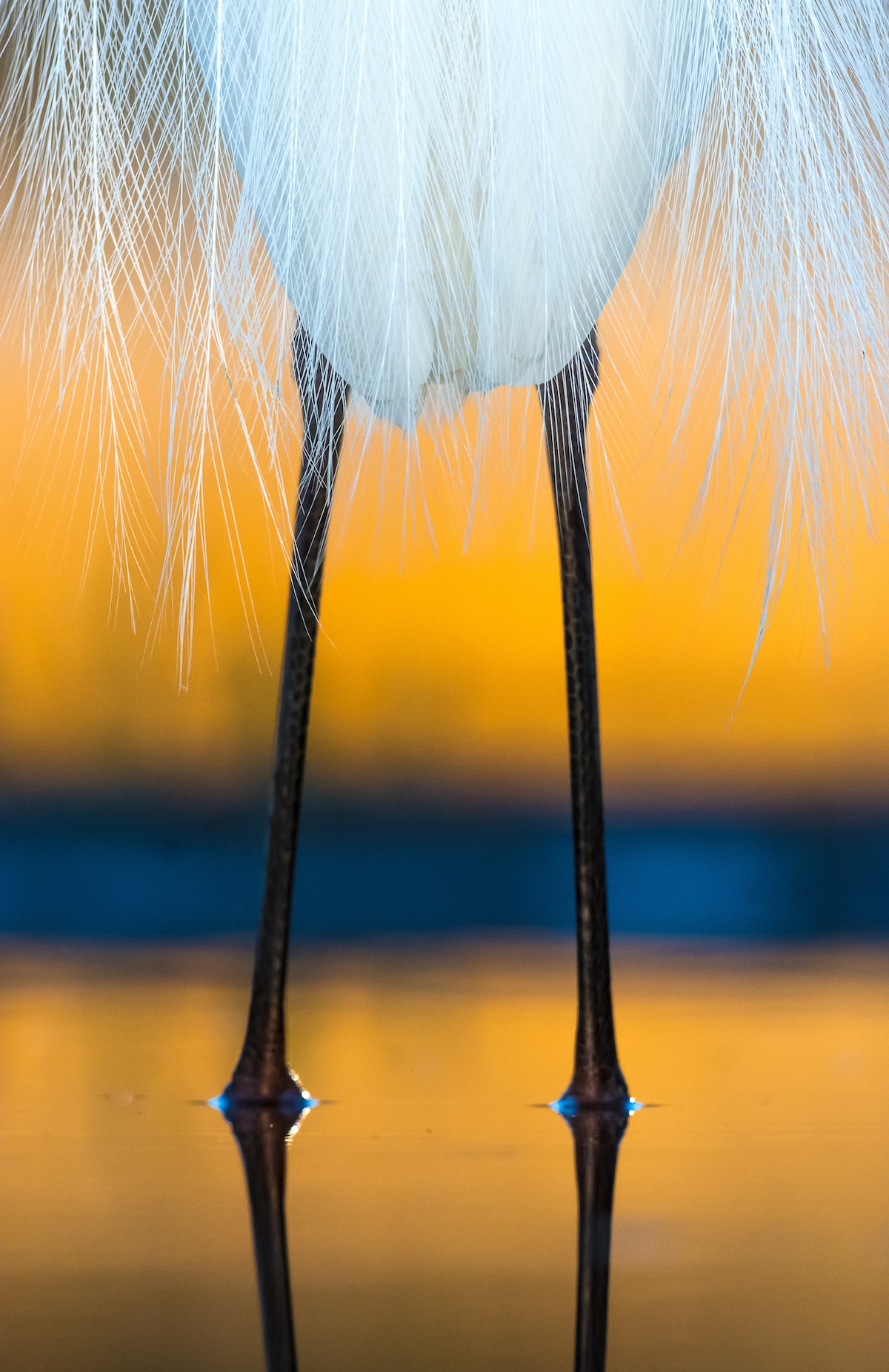
“Little Egret – Egretta garzetta.” by Csaba Tökölyi (Hungary). Silver Award, Attention to Detail. Photo taken in Pusztaszer, Hungary.
‘It had been a long night, lodged in a hide set up for nocturnal species. After those long dark hours packed with action photography, the breaking dawn presented a real treat. A Little Egret in wonderful breeding plumage stopped by and was standing at close range in the golden light of dawn reflected on the water’s surface. The elongated scapular feathers covered the bird like a gown in the lovely morning light. Instead of using wide-angle, I looked for a composition with my telephoto lens to try to record a different kind of image.’
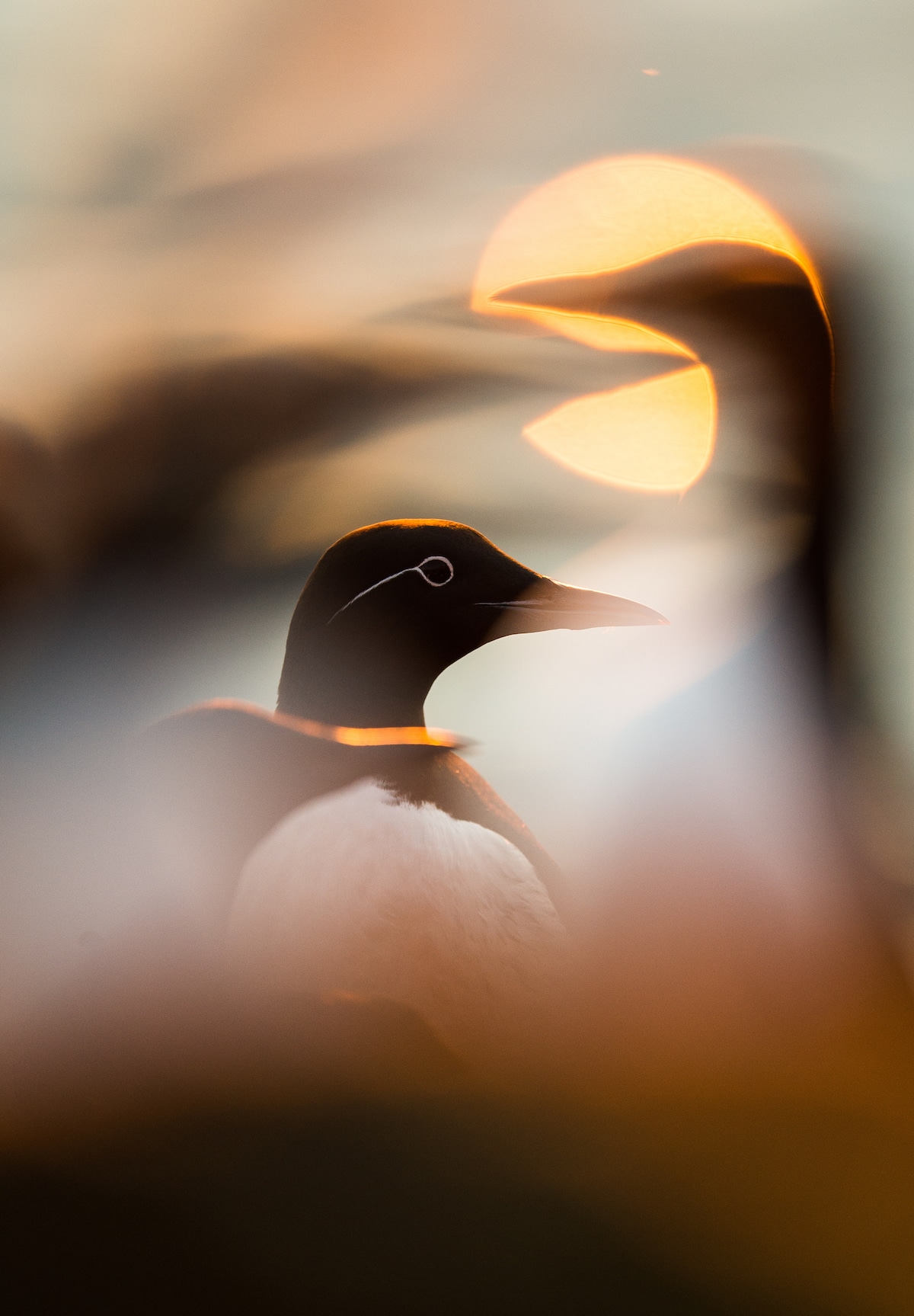
“Common Guillemot Uria aalge.” by Audun Lie Dahl, (Norway). Bronze Award, Creative Imagery. Photo taken in Hornøya, Finnmark, Norway.
‘Hornøya is a tiny island and boasts the northernmost bird cliffs in Norway, and each year thousands of Common Guillemots come here to breed. I have visited this place numerous times, and finally, I had the backlighting conditions I had been dreaming about. I used the lens aperture in such a way as to create pleasing ‘bokeh’ of the birds, as well as impressions of light caused by the sun reflecting off the ocean behind the birds.’
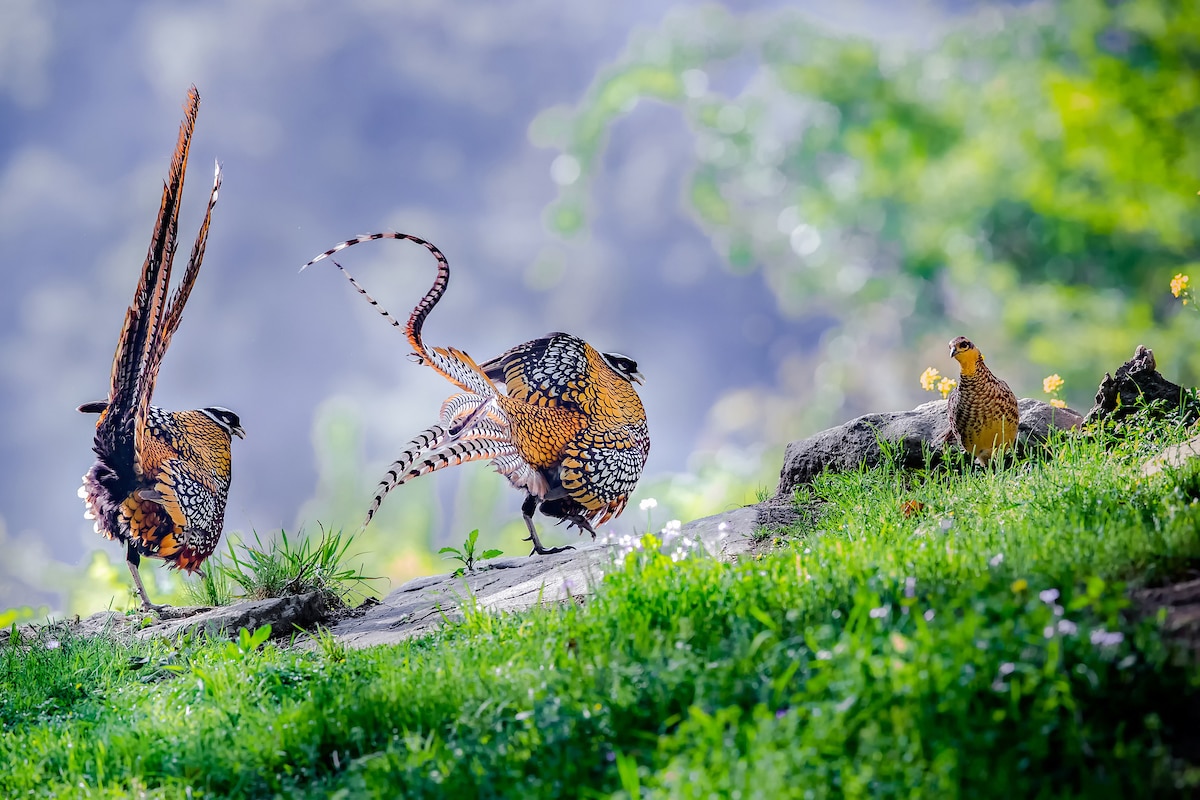
“Reeves’s Pheasant Syrmaticus reevesii.” by Hu Yi (China). Bronze Award, Bird Behavior. Photo taken in Xinyang City, Henan Province, China.
‘This image shows two male Reeves’s Pheasants, performing an elaborate display that I refer to as their ‘dancing steps’. The behavior is designed to attract the attention of the nearby female. The species is one of the most splendid and attractive of all protected birds in Xinyang City, Henan Province.’
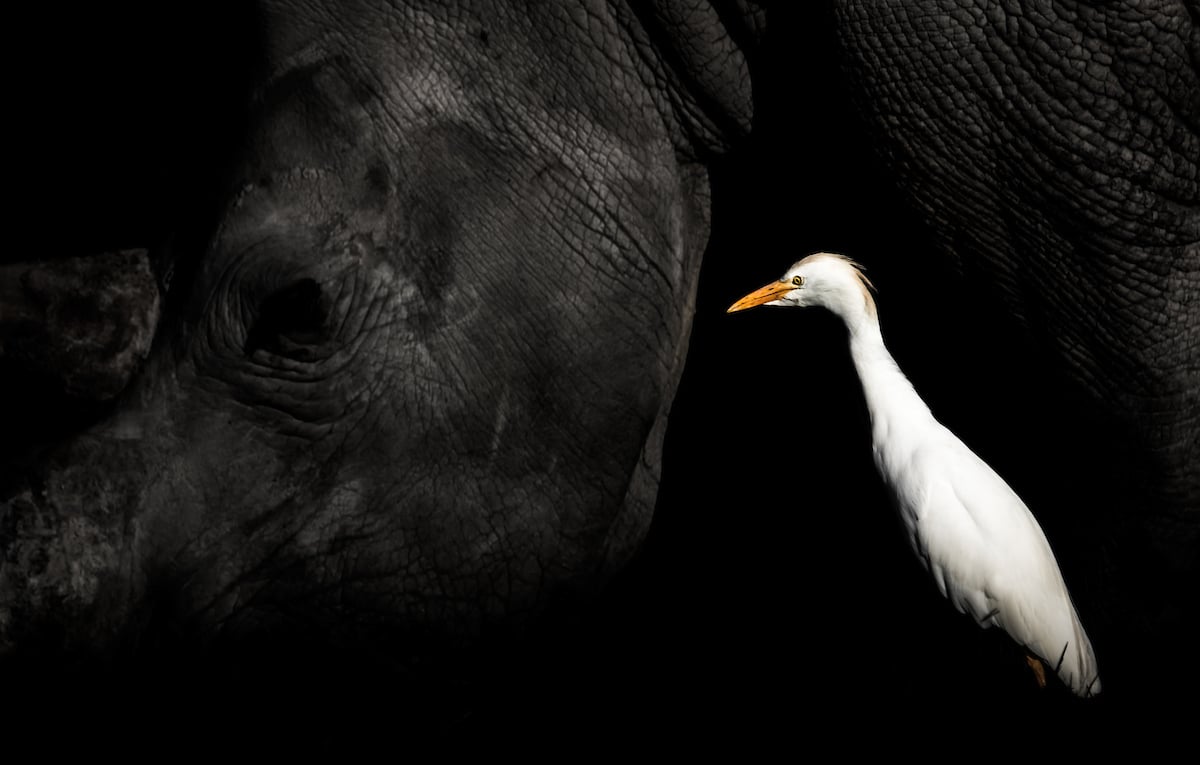
‘Cattle Egret Bubulcus ibis.'
by William Steel (United Kingdom/South Africa). Bronze Award, Best Portrait.
Photo taken in Khama Rhino Sanctuary, Botswana.
‘A Southern White Rhino continues grazing unaware of the bounty on its head, as a Western Cattle Egret searches for insects flushed from the grass. This is a truly commensal relationship. The Rhino is indifferent to the presence of the bird, while the egret benefits from the Rhino’s movement and foraging: it unwittingly disturbs insects concealed in the grass. For me, the image is such an emotive depiction: a juxtaposition between dark and light, hope and uncertainty. While the Cattle Egret takes center stage the Rhino can be see fading into the background, indicative of the species’ rapid decline.’
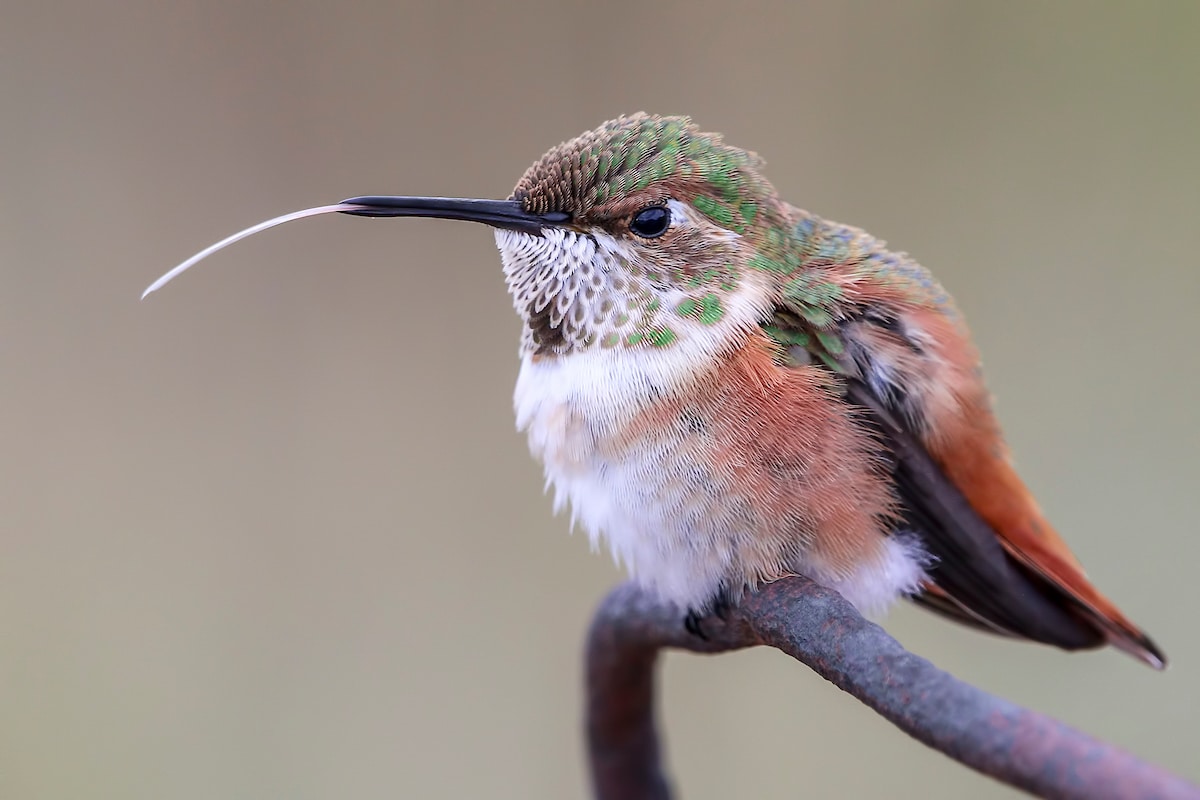
“Rufous Hummingbird Selasphorus rufus.” by Madeline Nolan (United States of America). Silver Award, Young Bird Photographer of the Year. Photo taken in Colorado, United States of America.
‘My family and I traveled to Creede, Colorado. My mom had just got a new camera and a big lens. Every morning, I would wake up, borrow the equipment and take pictures of the hummingbirds in the national forest. Some days, I would shoot for hours. I was able to capture this adorable female Rufous Hummingbird sticking her tongue out! I had never seen that before. It was not easy to capture and I am thrilled I was able to get such a neat shot.’

“Snowy Owl Bubo scandiacus.” by Chad Larsen (Canada). Gold Award, Garden and Urban Birds. Photo taken in Saskatchewan, Canada.
‘My wife and I had been photographing Snowy Owls for a couple of days during the Christmas Holidays in Saskatchewan. On this morning, I returned to the same area and could not believe what I was seeing… an all-white Snowy Owl on a quaint white church! Trying to focus on a white owl set against a very light backdrop proved to be very difficult. However, my biggest challenge was getting into a central position without disturbing this peaceful moment: I knew an opportunity like this might never happen again.’
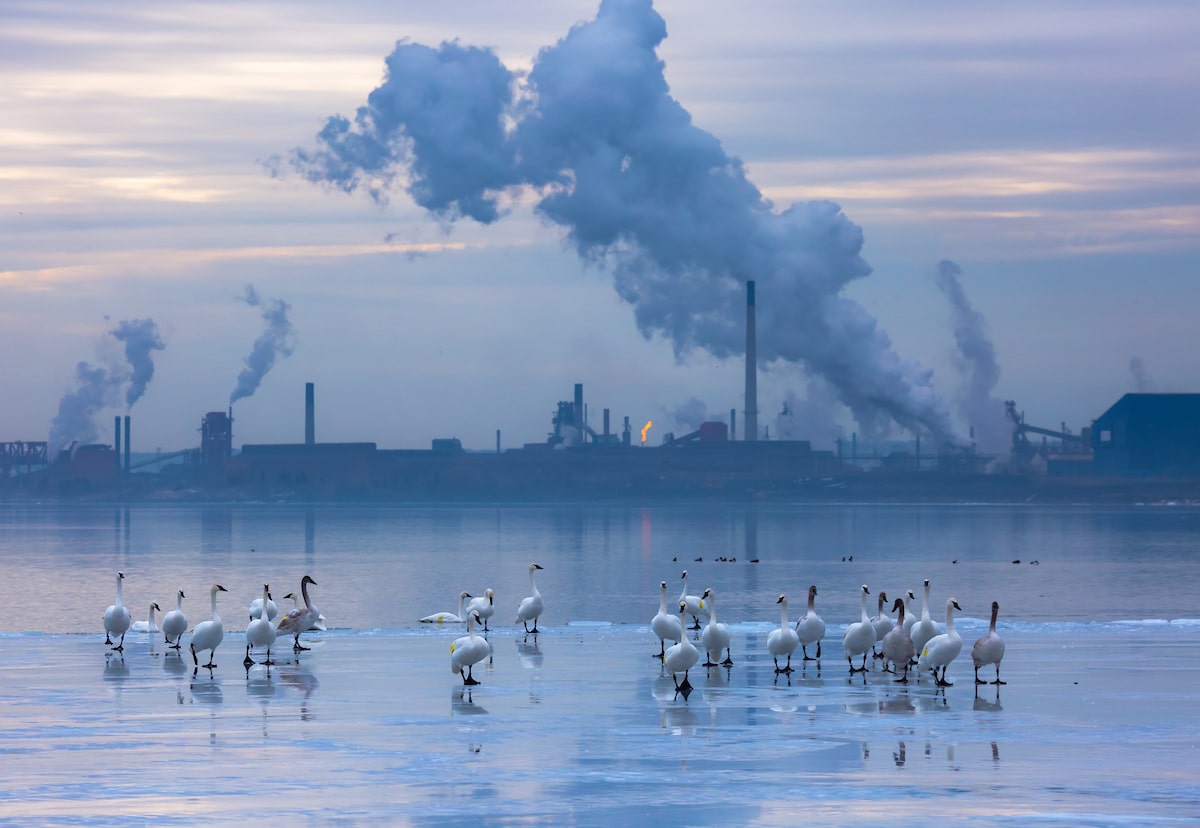
“Trumpeter Swan Cygnus buccinator.” by Meera Sulaiman (Canada). Silver Award, Garden and Urban Birds. Photo taken by Ontario, Canada.
‘This part of Lake Ontario is regarded as the biggest toxic coal-tar deposit in Canada, a by-product of more than 100 years of industrial waste. Its claim to fame is being the largest and most contaminated site on the Canadian side of the Great Lakes. However, it is also a winter home for Trumpeter Swans. These North American natives are the largest of their kind in the world and one of the heaviest flying birds; weighing up to 30 pounds they are held aloft on a wingspan of eight feet. Around 200 swans gather here every winter. Trumpeter Swans once nested over most of North America and some estimates placed their numbers, historically, at more than 100,000. But by the 1880s they were almost hunted out of existence and were locally extinct in Ontario, Canada. The Trumpeter Swan’s reintroduction to Ontario has been a story in the making for more than 30 years. I started to document this wonderful species three years ago after being moved by their recovery story.’
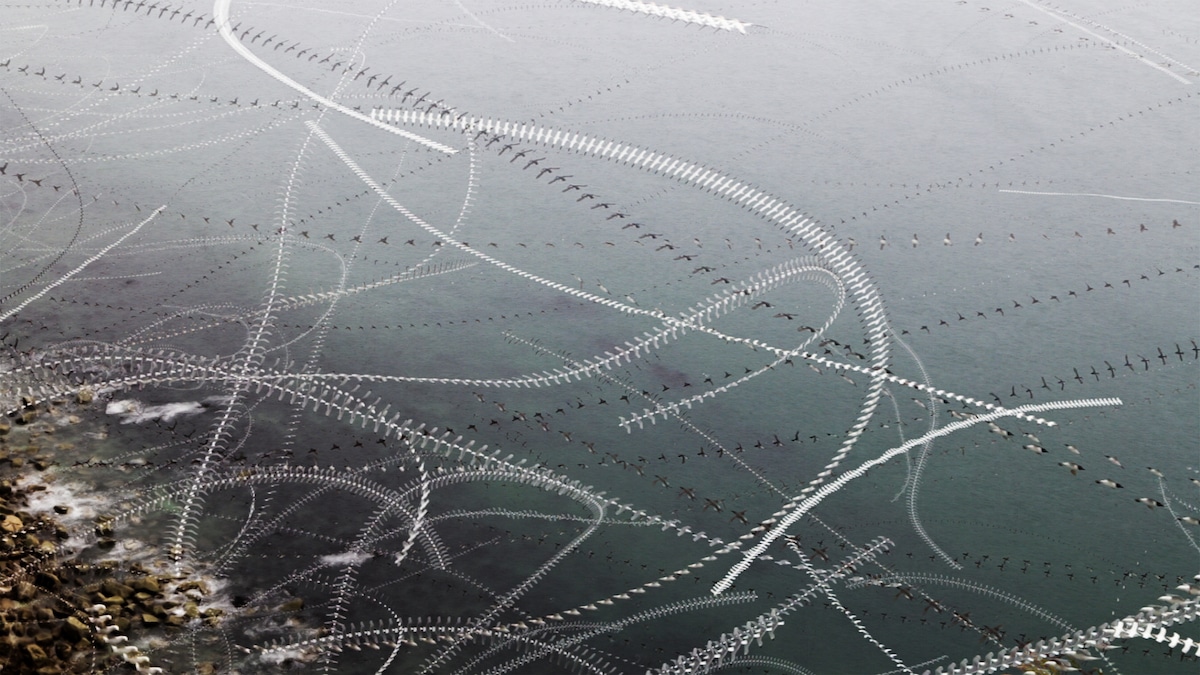
“Mixed Seabirds.” by Kathryn Cooper (United Kingdom) Silver Award, Creative Imagery. Photo taken in RSPB Bempton Cliffs, Yorkshire, United Kingdom.
‘I visited Bempton Cliffs in June 2018, a place where half a million seabirds gather; they are drawn by plentiful nesting sites located along a 17-mile stretch of cliffs that are up to 400 feet high. The sheer number of birds in the air is a true wildlife spectacle and difficult to depict in a photograph. This image is part of a larger creative project that combines my inquisitiveness for art, science, and nature. My background in science and programming allows me to write my own bespoke algorithms to compress the time dimension of a video onto a single image. To give you a sense of scale, this image contains ‘bird tracks’ captured over a five-second period.’
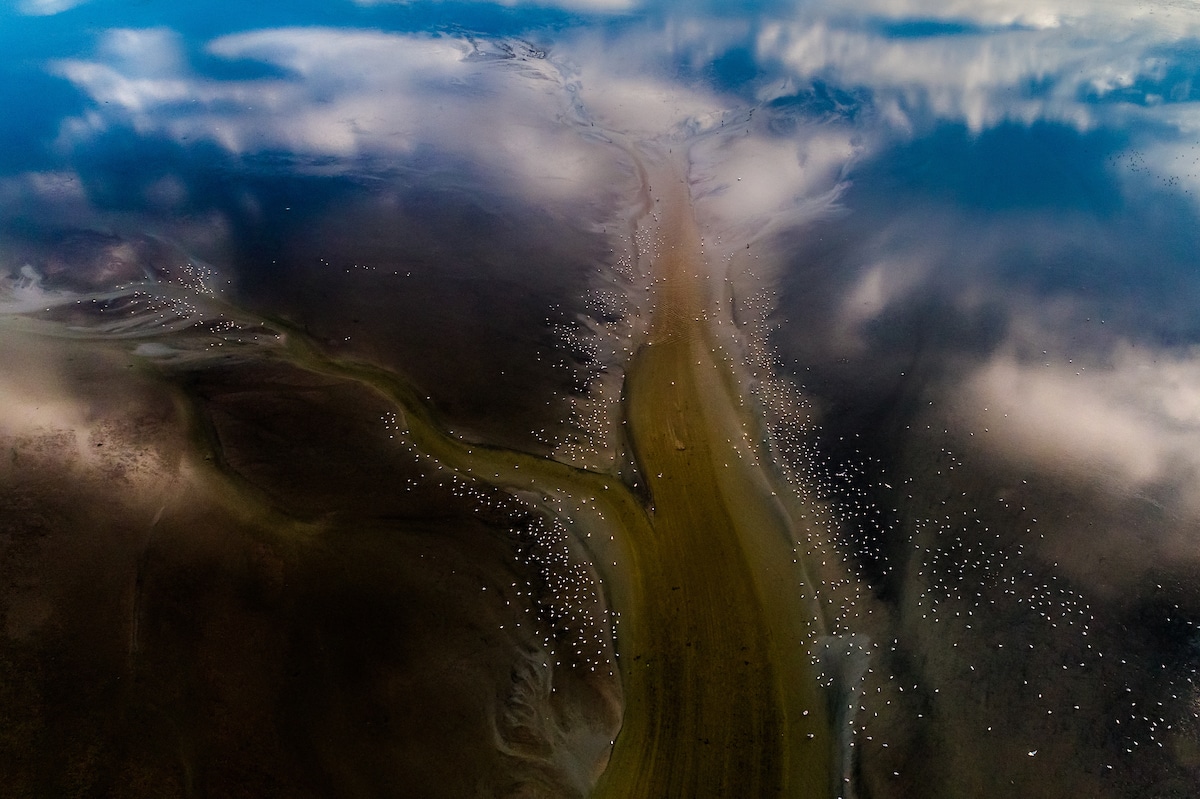
“Mixed Gulls.” by Mohammad Khorshed, (Kuwait). Gold Award, Birds in the Environment. Photo taken in Kuwait.
‘Low tide reveals the beauty of the coastal environment. The intertidal zone is also a good feeding area for seabirds, and so a lot of gulls and herons gather because of the abundance of life. I waited for many days to get the perfect combination of elements for the photo I had in mind: still water at low tide, beautiful clouds and of course the birds. I took this photo using a drone and the magic lasted just a short time before the rising tide altered the scene.’
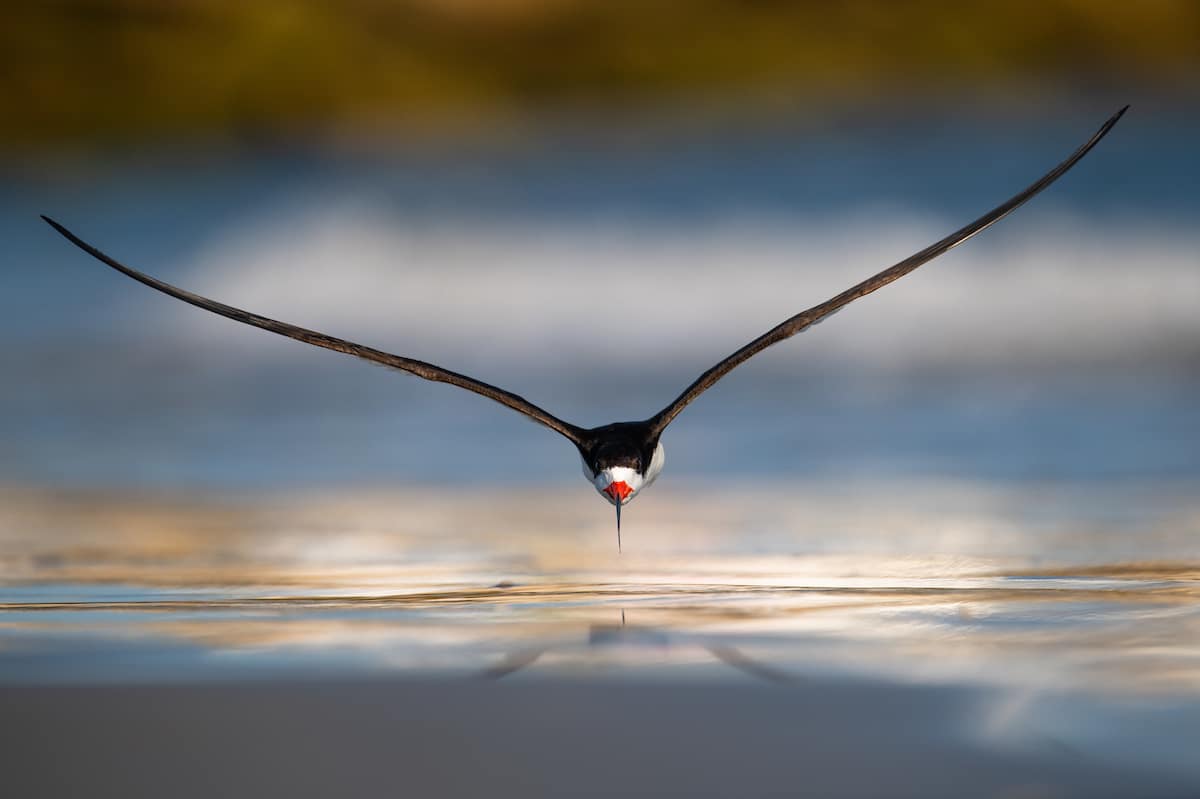
“Black Skimmer Rynchops niger.” by Nikunj Patel (United States of America). Gold Award, Birds in Flight. Photo taken in Ocean City, New Jersey, United States of America.
‘Black Skimmers are one of my favorite birds and I love spending time in the summer observing and photographing them. Skimmers have a light and elegant flight, with steady wing beats. They fly low over the water and dip their lower mandible just below the surface, feeling for tiny fish and snapping them up with deadly speed, and making high-speed turns in mid-flight. On a nice summer evening, I arrived at a colony of nesting seabirds on a beach to photograph Black Skimmers flying in, bringing fish for the new-born chicks. I decided to set up low on the beach as it would give me an eye-level perspective with the birds. A few skimmers had gathered at the edge of the shoreline and were having a vigorous bathing session. As some of them took off, I saw one flying low and straight towards me. Luckily, I was able to acquire focus, press the shutter and capture a beautiful image of the bird flying straight at me. Black Skimmers rely on open beaches for nesting and raising their young, with direct access to the water for feeding. Coastal development and our own love of the same beaches have left them with few safe places to nest.’
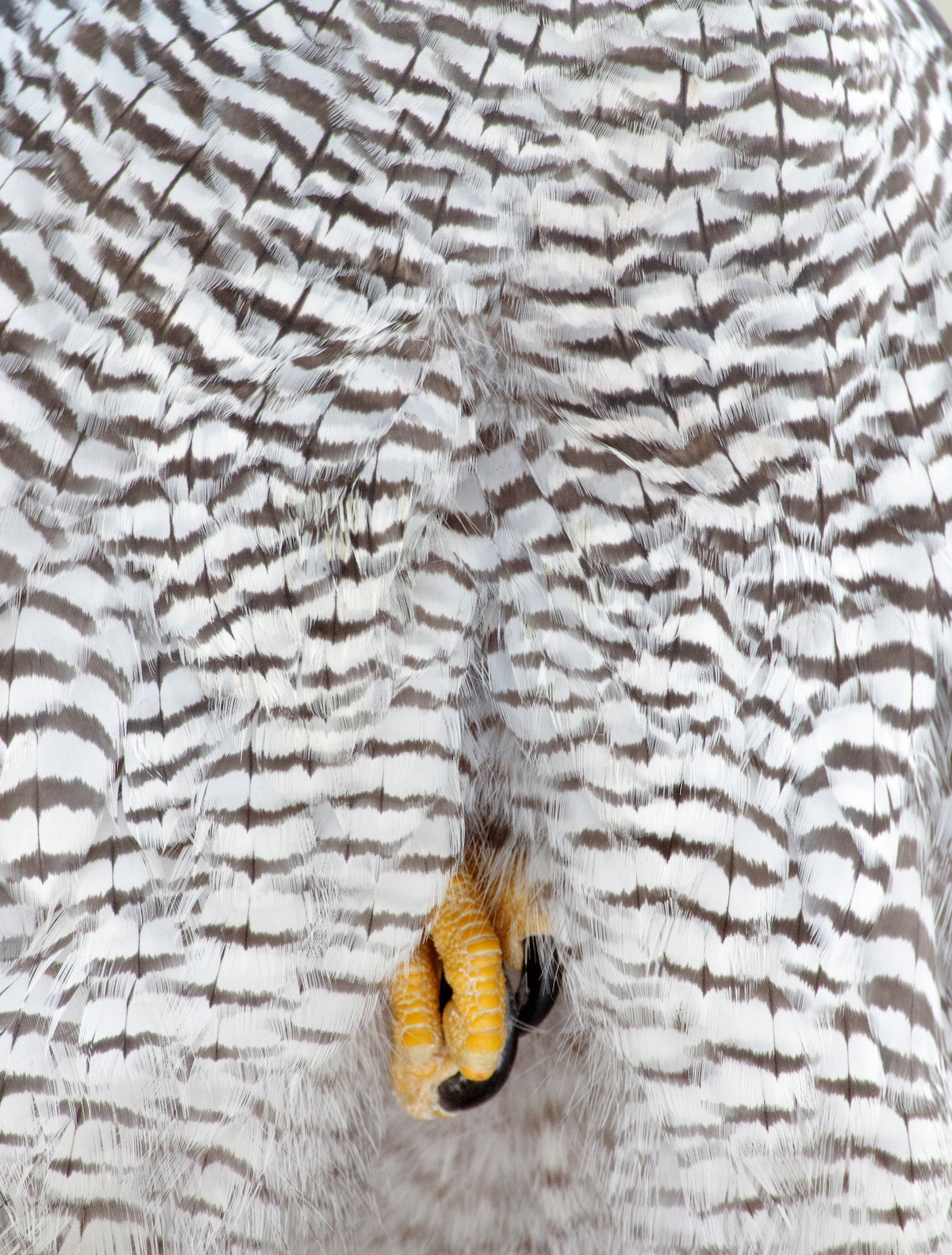
“Northern Goshawk – Accipiter gentilis.” by Pål Hermansen, (Norway) Gold Award, Attention to Detail.
Photo taken in Trøndelag, Norway.
‘This mature Goshawk was photographed while it visited a feeding place in the forest. Instead of taking standard images, showing the whole bird, I decided to put on a very long lens and try to pick out details in the feathers. When the feet appeared, I saw the image I had been dreaming of.'
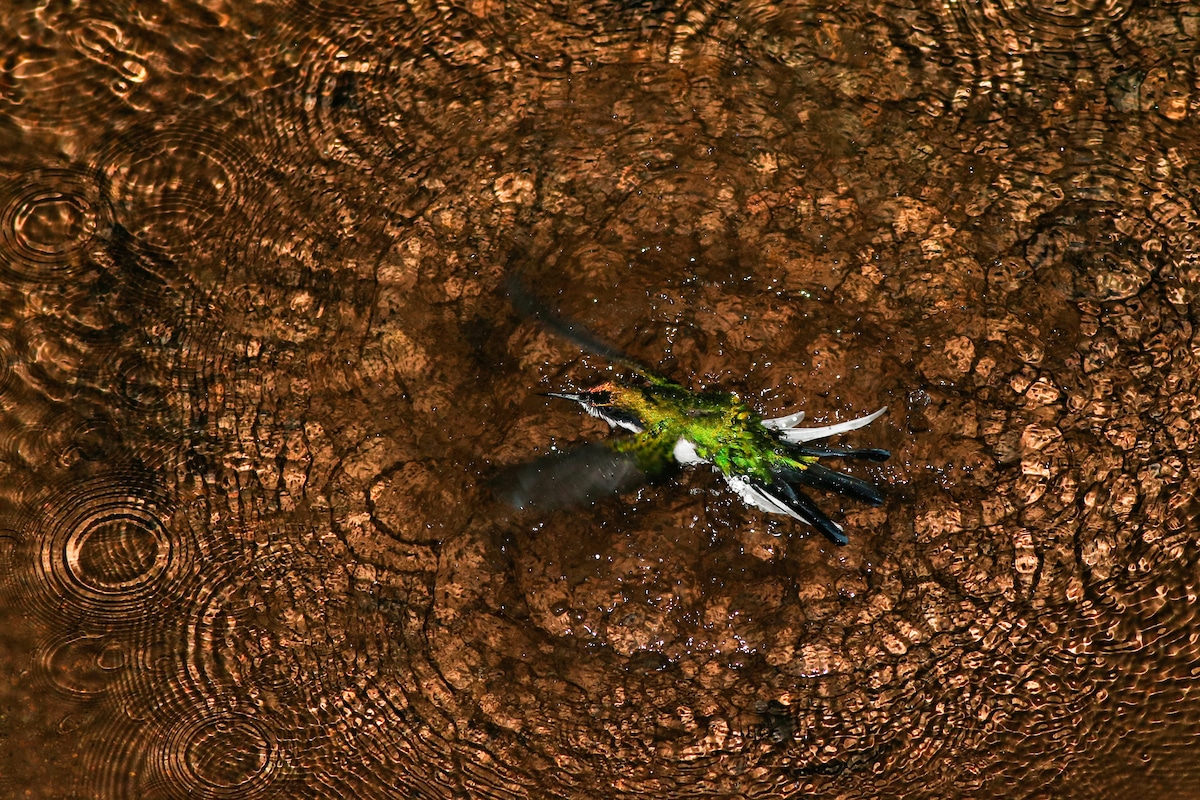
“Purple-crowned Fairy Heliothryx barroti.” by Ivan Sjögren (Sweden). Gold Award, Bird Behavior. Photo taken in Rancho Naturalista, Costa Rica.
‘Small natural pools deep into the rainforest make a perfect place for hummingbirds to have a quick bath. I was blessed to witness this behavior in Costa Rica early one morning. The birds hover over the water for a little time and then make small dips beneath the surface. I was able to capture the moment as a Purple-crowned Fairy left the water. The idea of using flash to highlight the rocks on the bottom of the water made the water look golden.’
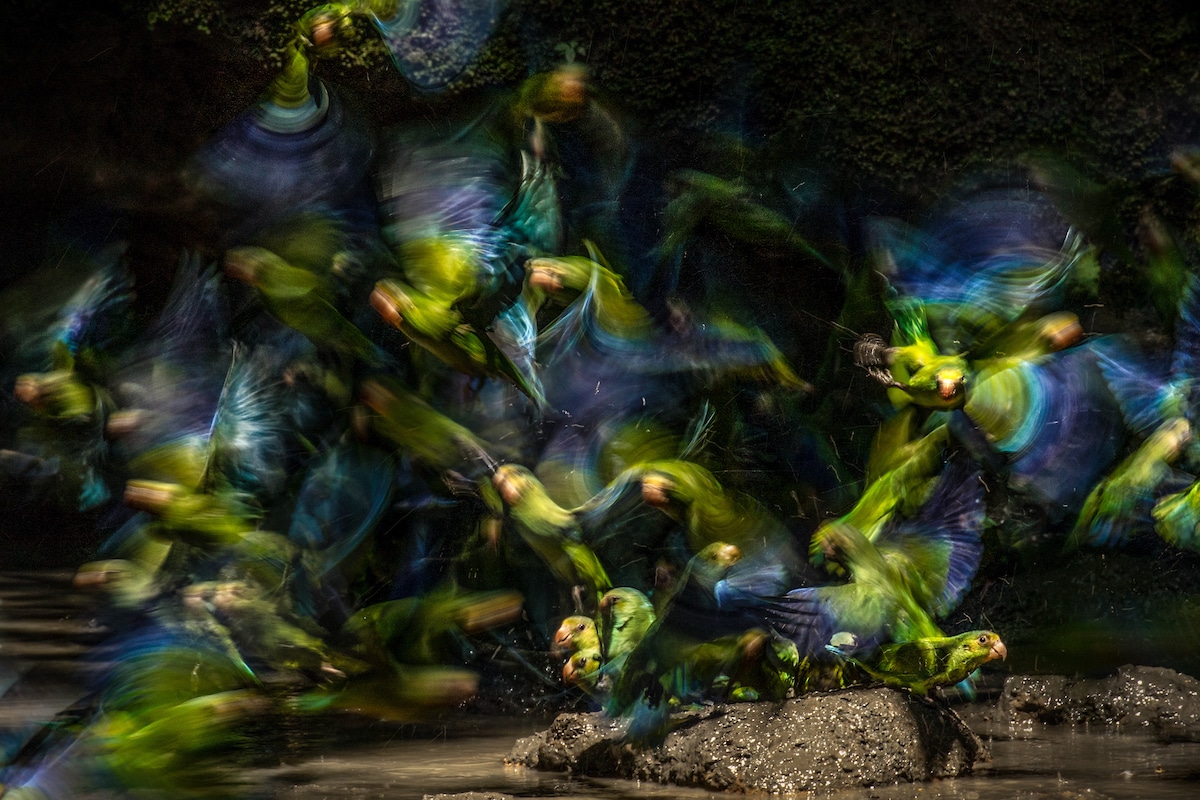
“Cobalt-winged Parakeet Brotogeris cyanoptera.”
by Liron Gertsman (Canada). Bronze Award, Birds in Flight. Taken in Yasuni National Park, Ecuador.
‘Scattered throughout the Amazon basin are hundreds of clay licks where parrots, parakeets, and macaws come to eat clay and neutralize the acidic fruits that they eat. Getting to the clay lick (and watering hole) where I took this photo required a regional flight, a three-hour boat ride upstream, and a short canoe ride to get to base camp. From base camp, it took another short boat ride and a 30-minute hike (a longer hike than usual due to low water levels in July 2017) each day to get to the clay lick. It took many hours of waiting over three days before we were treated to the sight of hundreds of Cobalt-winged Parakeets raining down on the forest floor. Seeing them and hearing the deafening roar of parakeet chatter was an experience I don’t think I’ll ever forget. After they drank the mineral rich-water and ate some clay, it was over; this photo captures the chaos as the parakeets took to the air, heading back to the canopy. I used a slow shutter speed to convey movement as the birds took to the air.’
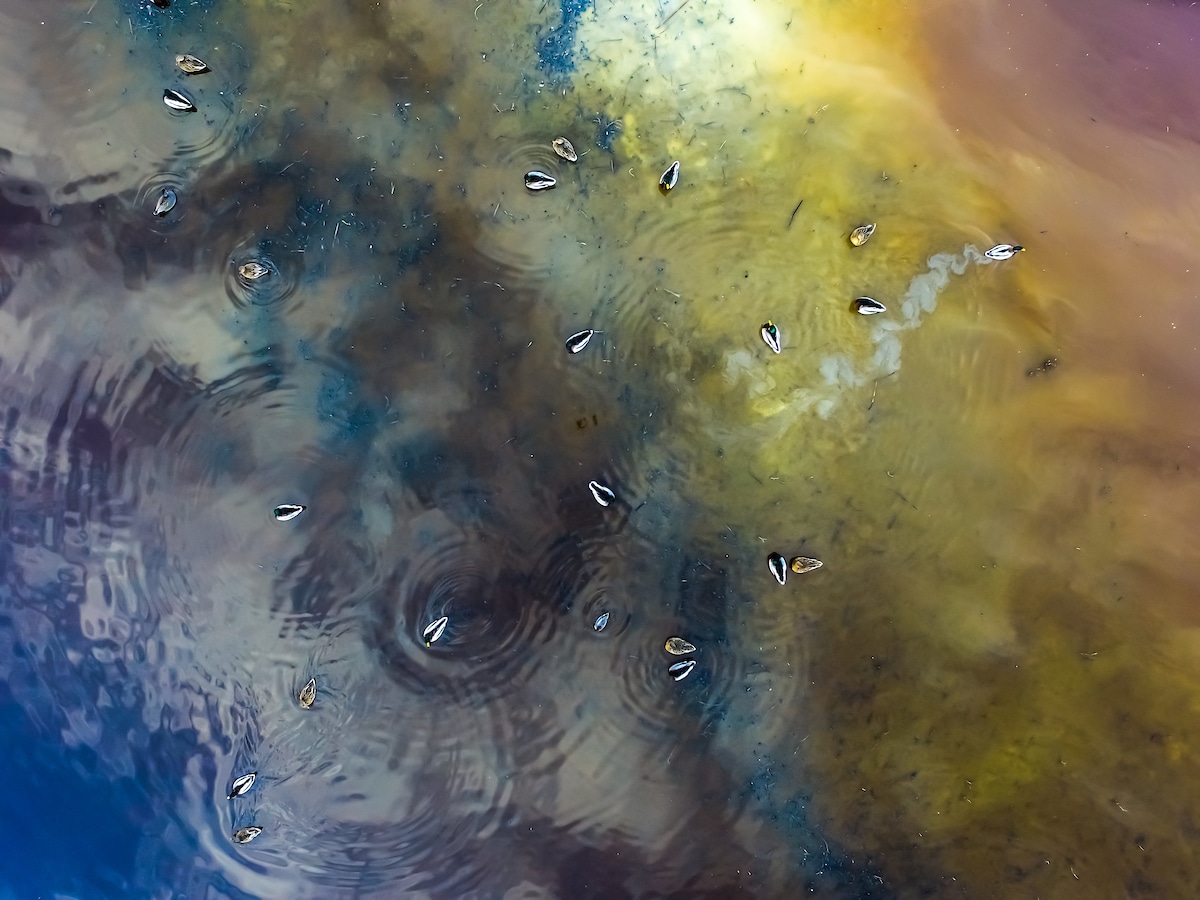
“Mallard Anas platyrhynchos.” by Tamás Koncz-Bisztricz (Hungary).
Gold Award, Young Bird Photographer of the Year. Photo taken in Hungary.
‘It’s late winter, and Hungary’s soda lakes are full of life, both above and below the surface of the water. These lakes are a sanctuary for a wide variety of water birds including Eurasian Teal, Eurasian Spoonbill, Great Egret, Greylag Goose, Greater White-fronted Goose, Common Black-headed Gull, Mediterranean Gull, Eurasian Coot, Grey Heron, and other birds. There is a nice, but unknown hidden lake between the village of Tömörkény and Pálmonostora. It is surrounded by reeds and sedges and therefore it is impossible to observe and photo the diverse life it harbors without causing a disturbance. I took this aerial photograph by a remotely controlled drone which causes almost no disturbance when used properly: the shape, color, and sound of this machine do not correspond to any predator. I used a special technique to slowly approach the birds from very high altitude, the same method used by conservation experts to count the population of the birds for scientific purposes. Here we can see wild Mallards stirring up the muddy water and leaving lines in the water, colored yellowish-brownish by organic materials. Sometimes you can see a purple tinge to the water, the result of organic matter released from decomposing reeds. The sparkling color pallet of the image in the photograph is also influenced by the blue sky and the reflection of white clouds on the water surface.’
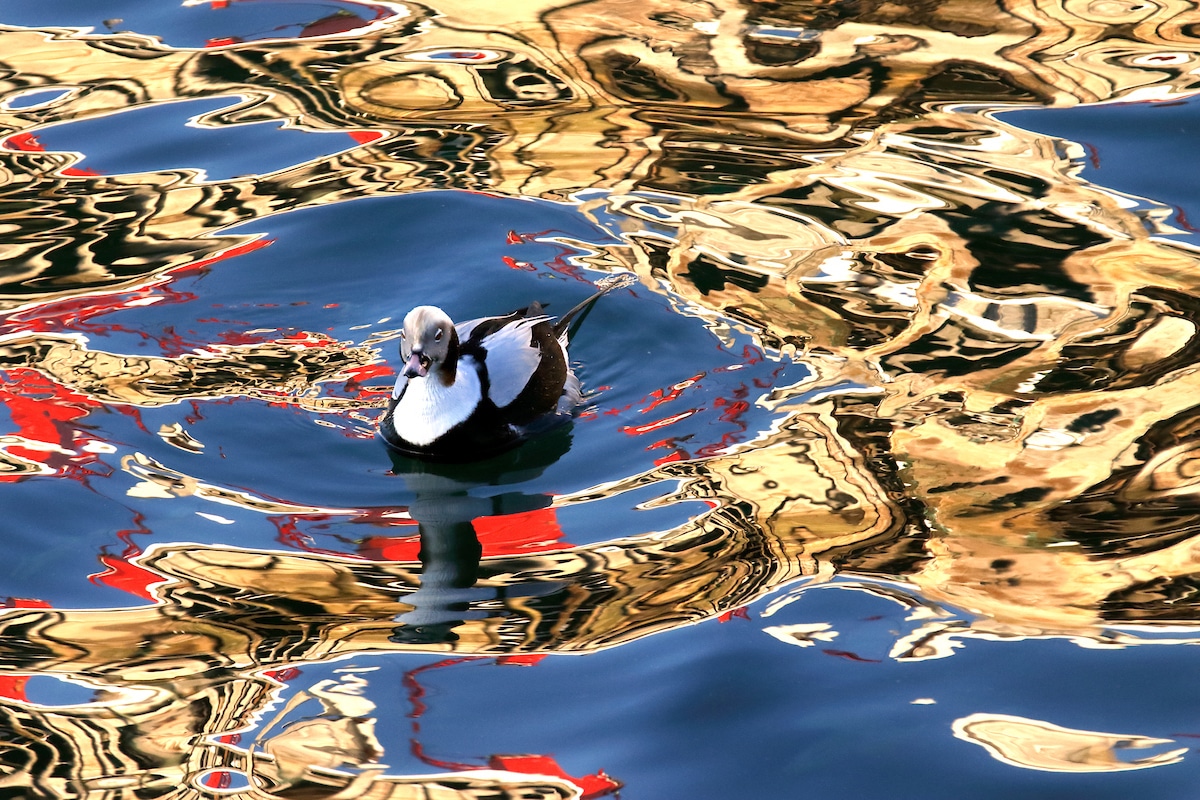
“Long-tailed Duck Clangula hyemalis.” by Martin Eschholz (Germany). Bronze Award, Garden and Urban Birds. Photo taken in Port of Vardø, Varanger, Norway.
‘White everywhere. That is the first impression when visiting the Varanger Peninsula in the Arctic north of Norway in winter. But a surprising amount of color can be found too, especially in the region's various harbors. The port of Vardø is a working fishing harbor attracting several species of wintering sea ducks. One of the most fascinating is the Long-tailed Duck and at first glance, it looks too feebly built to survive in the arctic. But the reality is that it can cope perfectly. A bit of extra food like offal from a fish factory comes in handy and that is the reason these birds swim between the harbor's colorful reflections.’
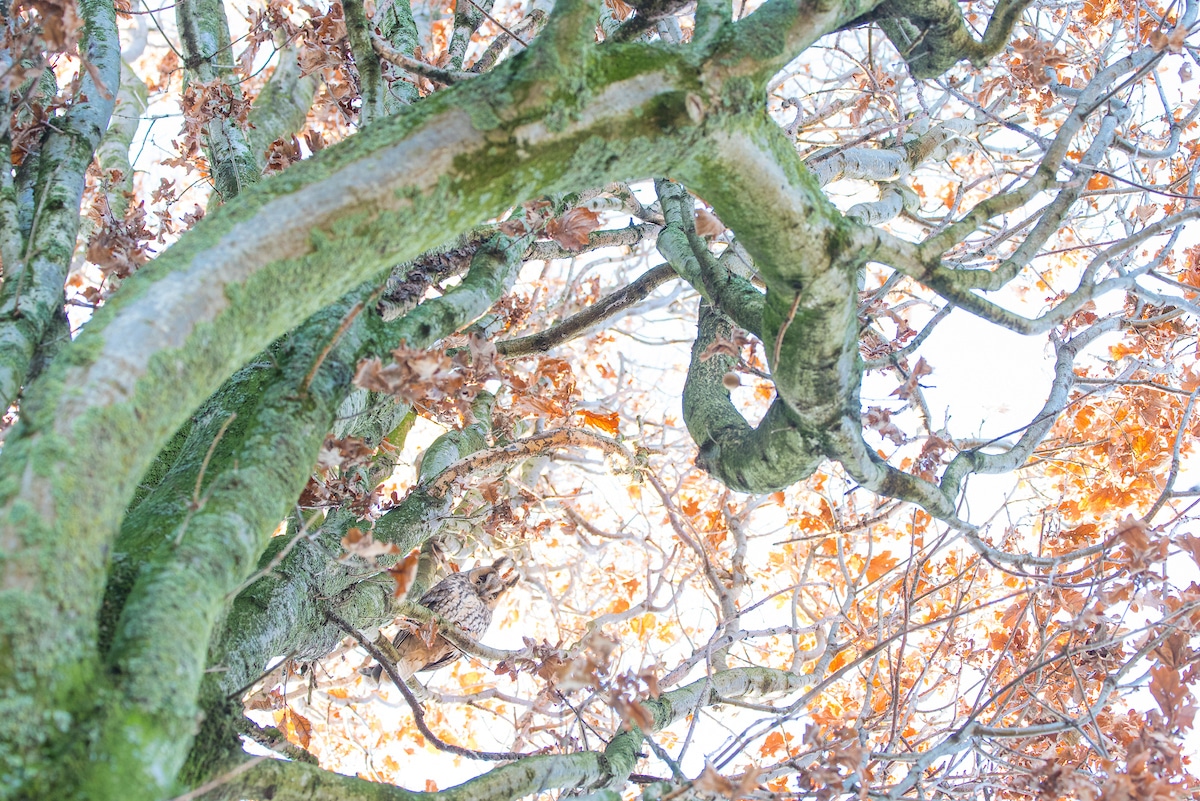
“Long-eared Owl Asio otus.” by Edwin Giesbers, (The Netherlands). Silver Award, Birds in the Environment. Photo taken in Balgoij, The Netherlands.
‘Most owl species lead a solitary life, but when autumn makes its appearance, Long-eared Owls are sometimes more gregarious. From September to April, some birds sleep in close proximity to one another during the daytime in so-called roost trees; in some cases, these trees have been used for decades. Who knows, they could be in your neighborhood because often these roost trees are located in residential areas. Trees like Beech and Silver Birch are used in autumn. But as these trees lose their leaves, the birds often move to a nearby Yew or fir where they are less noticeable than in a bare tree.’

“Grey Heron Ardea cinerea.” by Jozsef Gergely (Serbia). Silver Award, Bird Behavior. Photo taken in Kanjiza, Serbia.
‘Recently I visited a fish-farm near Kanjiza in the northern Serbian province of Vojvodina. As you can imagine, the abundance of corralled fish acts like a magnet for fish-eating birds such as the Grey Heron. This particular individual caught my eye: despite its size and bulk, it was doing an extremely good job balancing on one of the fishing nets. I love the ëhigh keyí effect achieved by shooting into the light.í
Nikon D300 with Sigma 120-300mm f/2.8 lens. 240mm focal length; 1/2,500 second; f/7.1; ISO 250. Handheld.











































































